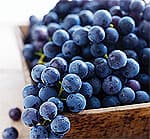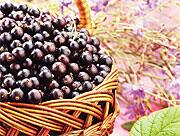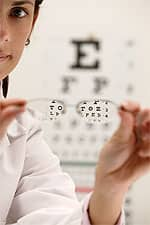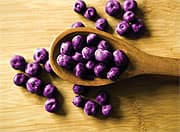Life Extension Magazine®
System-wide free radical damage to healthy cells is an age accelerator. In experimental models, when genes are inserted that boost internal defenses against free radicals, life span can be extended by nearly 100%.1-3 The good news is that natural compounds found in certain plants (polyphenols) can exert similar effects in aging humans. They have been shown to favorably modulate gene expression that blunts free radical injury at the molecular level. Among the most powerful of these are anthocyanins. Anthocyanins are pigmentary compounds that lend fruits like grapes, blueberries, and black currants their dark color. Scientists are increasingly focusing on the benefits of one anthocyanin in particular: cyanidin-3-glucoside or C3G.1 Scores of studies in the past two years have established its potent combination of antioxidant, anti-inflammatory, DNA-protective, and gene-regulating effects. In this article, you will learn how C3G’s multimodal mechanisms reduce free radical activity. You will find the latest research on its ability to combat numerous age-related conditions, including cancer, heart disease, and metabolic syndrome. You will also discover its newly identified, singular power to enhance night vision. An Exceptional Multitargeted NutrientPlants are relentlessly exposed to ultraviolet sunrays. To survive this daily onslaught, certain plants produce compounds that specifically reduce free radical damage. These compounds are known as polyphenols, a large class of biologically active molecules.4-6 Polyphenols are chemicals that, by their intrinsic structure, diminish the effects of free radicals on surrounding tissue.5,7
The anthocyanin class of polyphenols is especially effective in blunting this form of damage. And C3G is the most common of the anthocyanins found in dark fruits—which come from plants that thrive best in direct sunlight, where free radicals are generated in abundance.8,9 It’s no accident, then, that C3G has recently been shown to provide animal and human tissues optimal defense from free radical attack, both by preventing their formation and by scavenging those already formed.7,9-12 What has researchers so interested in C3G, however, is that it also protects from the “downstream” consequences of free radicals at the genetic level. Perhaps the most subtle and intriguing effect of C3G on human tissue is its ability to directly influence gene expression.13 While we carry genes for every protein and structure in our bodies, only a few of those thousands of genes are active at any given moment. C3G selectively upregulates genes that confer protection on aging tissues, while downregulating those that cause damage (such as pro-inflammatory cytokines).14,15 C3G is well-absorbed from the intestinal tract in both animals and humans, and it readily reaches therapeutic levels in the bloodstream.16,17 Anti-Cancer PowerHigh intake of fruits and vegetables is associated with protection from most forms of cancer. One unique mechanism is attributed to the polyphenols in the anthocyanin family.7 These brightly colored molecules, including C3G, afford protection against most of the events in the cascade of cancer formation.18,19 Antioxidant activity supplied by anthocyanins, including C3G, protects DNA from the damage that can initiate cancers.20 Activation of so-called oncogenes (genes that induce cancer-cell reproduction) is another early step in cancer development. C3G potently inhibits a common oncogene called ras in human cells transplanted into rats.21 Suppression of the inflammatory “master switch” that links inflammation to cancer causation (NF-kB) can prevent many of the “second hits” that promote cancer development.22,23 C3G potently inhibits NF-kB in many tumor types.7,24 Once a cancer gets started, it can invade local tissue and/or metastasize into other areas of the body. C3G and other anthocyanins can prevent expression of the proteins that cancer cells produce to help them invade.25,26 The body’s own natural defense against cancer is programmed cell death (apoptosis). Anthocyanins such as C3G can upregulate so-called “suicide pathways” that trigger apoptosis in cancer cells, while sparing normal tissue.21,27-31 This can be a key fact that can delay or even eliminate tumor growth. Tumor cells, like all mammalian cells, go through a cycle of changes as they replicate. Anthocyanins can block the cell cycle, causing what amounts to a microscopic traffic jam and preventing cancer cells from proliferating in a coordinated fashion.32 C3G has also been shown to take the “bite” out of cancer cells. Scientists tell us that cancer cells exist in a state known as “undifferentiated.” That means that they don’t form cohesive and functional structures such as a lung or a liver. C3G has been found to induce normal differentiation of certain cancers, particularly dangerous melanoma cells.33 When cancer cells differentiate, their potential to cause damage is gravely impaired. By all of these different mechanisms, C3G has been shown to impair cancer cell growth, development, and spread in a variety of human cancers in laboratory and animal studies. C3G shows promise in mitigating breast, colon, lung, esophageal, and skin cancers.7,8,24,34,35 System-Wide Cardiovascular DefenseCardiovascular disease continues to be the leading cause of preventable death in older adults. C3G offers protection at several vital levels in the chain of events leading to heart attacks and stroke. Anthocyanins such as C3G inhibit nitrogen free radicals that trigger endothelial dysfunction.36,37 At the same time, C3G promotes healthy endothelial cells, where it contributes to vascular integrity and the ability to respond to blood pressure changes.38 C3G helps reduce cholesterol levels in laboratory studies, thus lowering the risk of lipid oxidation, which triggers inflammation and atherosclerosis.39 Antioxidant benefits of C3G and other anthocyanins help prevent that lipid oxidation, while also preventing the inflammation itself.40 Once atherosclerotic plaques form, C3G can stabilize them and reduce the risk that they’ll rupture and cause a catastrophic heart attack or stroke.41 Remarkably, C3G also inhibits the blood pressure-boosting hormone called angiotensin-converting enzyme (ACE), which may help keep blood pressure under control.42
|
||||||
Combating Diabesity and the Metabolic SyndromeThe combination of obesity and diabetes has been referred to as “diabesity,” and is widely recognized as a precursor to metabolic syndrome.43 Scientists have convincingly demonstrated that C3G suppresses body weight gain in animals given a high fat diet.44 Astonishingly, the supplementation also completely normalized blood sugar and insulin elevations, and blocked elevation of the fat-associated cytokine leptin. These researchers also showed that C3G enhances secretion of beneficial cytokines such as adiponectin, which can help prevent progression to diabetes.45 These effects are produced by beneficial changes in expression of hundreds of genes.15 C3G also lowers blood sugar and enhances insulin sensitivity by downregulating a fat-related cytokine that contributes to insulin resistance.14 An astonishing and yet-to-be fully explored benefit of the anthocyanins is their ability to inhibit intestinal enzymes that break down starch for absorption. By blocking those enzymes, calories contained in starch remain in the intestinal tract and can’t contribute to weight gain. C3G and others in its family offer potent suppression of intestinal alpha-glucosidase and pancreatic alpha-amylase, two enzymes that can cause excess glucose absorption to occur.46-48
C3G Restores Night VisionThe ability to see well in low-light conditions deteriorates rapidly with age, placing maturing individuals in greater danger of accidental falls, car accidents, and other preventable, injurious hazards. A primary cause of this so-called “night blindness” is light damage and oxidative stress in the retina. The retina is constantly exposed to highly focused beams of light, which include dangerous ultraviolet radiation. C3G offers protection at several vital levels in the chain of events leading to heart attacks and stroke. C3G plays a unique role in protecting retinal tissue from damage. It works by multiple mechanisms at several sites in the retina. Most importantly, C3G stimulates regeneration of the retinal pigment called rhodopsin.56 Rhodopsin is vital to vision in dim light. When depleted, rhodopsin takes longer to return to its normal, light-sensitive state. C3G increases the restoration of rhodopsin levels.57,58 C3G also serves to protect retinal cells against the harmful oxidation that is triggered by light.59 It accomplishes this by reducing the accumulation of a fluorescent pigment called A2E that amasses with age and interferes with normal retinal function. C3G’s ability to quench oxygen free radicals is credited with this effect.59 Retinal cells are nerve cells that are capable of transmitting electrical signals. C3G and other cyanidin components of berries have neuroprotective effects on retinal cells.60 SummaryPlant-based nutrients known as anthocyanins and their major component, C3G, afford aging humans multimodal protection against a broad spectrum of degenerative diseases. C3G offers comprehensive antioxidant protection, powerful control of inflammation at multiple levels, marked reduction in DNA damage, and beneficial regulatory effects on hundreds of vital genes. It confers real-world protection against age-related conditions ranging from night blindness to cardiovascular disease, cancer, diabetes, and obesity.
If you have any questions on the scientific content of this article, please call a Life Extension® Health Advisor at 1-866-864-3027. | ||||||
| References | ||||||
| 1. Beckman K, Ames B .The free radical theory of aging matures. Physiol Rev. 1998 Apr;78(2):547-81. 2. Sohal R, Weindruch R. Oxidative stress, caloric restriction, and aging. Science. 1996 Jul 5;273(5271):59-63. 3 Rogina B, Reenan RA, Nilsen SP, Helfand SL. Extended life-span conferred by cotransporter gene mutations in Drosophila. Science. 2000 Dec 15;290(5499):2137-40. 4. Flors C, Nonell S. Light and singlet oxygen in plant defense against pathogens:phototoxic phenalenone phytoalexins. Acc Chem Res. 2006 May;39(5):293-300. 5. Kleindt CK, Stracke R, Mehrtens F, Weisshaar B. Expression analysis of flavonoid biosynthesis genes during Arabidopsis thaliana silique and seed development with a primary focus on the proanthocyanidin biosynthetic pathway. BMC Res Notes. 2010;3:255. 6. Munne-Bosch S, Jubany-Mari T, Alegre L. Enhanced photo- and antioxidative protection, and hydrogen peroxide accumulation in drought-stressed Cistus clusii and Cistus albidus plants. Tree Physiol. 2003 Jan;23(1):1-12. 7. Ding M, Feng R, Wang SY, et al. Cyanidin-3-glucoside, a natural product derived from blackberry, exhibits chemopreventive and chemotherapeutic activity. J Biol Chem. 2006 Jun 23;281(25):17359-68. 8. Cooke D, Schwarz M, Boocock D, et al. Effect of cyanidin-3-glucoside and an anthocyanin mixture from bilberry on adenoma development in the ApcMin mouse model of intestinal carcinogenesis--relationship with tissue anthocyanin levels. Int J Cancer. 2006 Nov 1;119(9):2213-20. 9. Saric A, Sobocanec S, Balog T, et al. Improved antioxidant and anti-inflammatory potential in mice consuming sour cherry juice (Prunus Cerasus cv. Maraska). Plant Foods Hum Nutr. 2009 Dec;64(4):231-7. 10. Guo H, Ling W, Wang Q, Liu C, Hu Y, Xia M. Cyanidin 3-glucoside protects 3T3-L1 adipocytes against H2O2- or TNF-alpha-induced insulin resistance by inhibiting c-Jun NH2-terminal kinase activation. Biochem Pharmacol. 2008 Mar 15;75(6):1393-401. 11. Li CY, Xu HD, Zhao BT, Chang HI, Rhee HI. Gastroprotective effect of cyanidin 3-glucoside on ethanol-induced gastric lesions in rats. Alcohol. 2008 Dec;42(8):683-7. 12. Delazar A, Khodaie L, Afshar J, Nahar L, Sarker SD. Isolation and free-radical-scavenging properties of cyanidin 3-O-glycosides from the fruits of Ribes biebersteinii Berl. Acta Pharm. 2010 Mar 1;60(1):1-11. 13. Tsuda T, Ueno Y, Yoshikawa T, Kojo H, Osawa T. Microarray profiling of gene expression in human adipocytes in response to anthocyanins. Biochem Pharmacol. 2006 Apr 14;71(8):1184-97. 14 Sasaki R, Nishimura N, Hoshino H, et al. Cyanidin 3-glucoside ameliorates hyperglycemia and insulin sensitivity due to downregulation of retinol binding protein 4 expression in diabetic mice. Biochem Pharmacol. 2007 Dec 3;74(11):1619-27. 15 Tsuda T, Ueno Y, Kojo H, Yoshikawa T, Osawa T. Gene expression profile of isolated rat adipocytes treated with anthocyanins. Biochim Biophys Acta. 2005 Apr 15;1733(2-3):137-47. 16. Miyazawa T, Nakagawa K, Kudo M, Muraishi K, Someya K. Direct intestinal absorption of red fruit anthocyanins, cyanidin-3-glucoside and cyanidin-3,5-diglucoside, into rats and humans. J Agric Food Chem. 1999 Mar;47(3):1083-91. 17. Marczylo TH, Cooke D, Brown K, Steward WP, Gescher AJ. Pharmacokinetics and metabolism of the putative cancer chemopreventive agent cyanidin-3-glucoside in mice. Cancer Chemother Pharmacol. 2009 Nov;64(6):1261-8. 18. Hagiwara A, Miyashita K, Nakanishi T, et al. Pronounced inhibition by a natural anthocyanin, purple corn color, of 2-amino-1-methyl-6-phenylimidazo[4,5-b]pyridine (PhIP)-associated colorectal carcinogenesis in male F344 rats pretreated with 1,2-dimethylhydrazine. Cancer Lett. 2001 Sep 28;171(1):17-25. 19. Dai J, Gupte A, Gates L, Mumper RJ. A comprehensive study of anthocyanin-containing extracts from selected blackberry cultivars: extraction methods, stability, anticancer properties and mechanisms. Food Chem Toxicol. 2009 Apr;47(4):837-47. 20. Duthie SJ, Gardner PT, Morrice PC, et al. DNA stability and lipid peroxidation in vitamin E-deficient rats in vivo and colon cells in vitro--modulation by the dietary anthocyanin, cyanidin-3-glycoside. Eur J Nutr. 2005 Jun;44(4):195-203. 21. Fukamachi K, Imada T, Ohshima Y, Xu J, Tsuda H. Purple corn color suppresses Ras protein level and inhibits 7,12-dimethylbenz[a]anthracene-induced mammary carcinogenesis in the rat. Cancer Sci. 2008 Sep;99(9):1841-6. 22. MacFarlane AJ, Stover PJ. Convergence of genetic, nutritional and inflammatory factors in gastrointestinal cancers. Nutr Rev. 2007 Dec;65(12 Pt 2):S157-66. 23. Sakamoto K, Maeda S. Targeting NF-kappaB for colorectal cancer. Expert Opin Ther Targets. 2010 Jun;14(6):593-601. 24. Hecht SS, Huang C, Stoner GD, et al. Identification of cyanidin glycosides as constituents of freeze-dried black raspberries which inhibit anti-benzo[a]pyrene-7,8-diol-9,10-epoxide induced NFkappaB and AP-1 activity. Carcinogenesis. 2006 Aug;27(8):1617-26. 25. Chen PN, Chu SC, Chiou HL, Kuo WH, Chiang CL, Hsieh YS. Mulberryanthocyanins, cyanidin 3-rutinoside and cyanidin 3-glucoside, exhibited an inhibitory effect on the migration and invasion of a human lung cancer cell line. Cancer Lett. 2006 Apr 28;235(2):248-59. 26. Chen PN, Kuo WH, Chiang CL, Chiou HL, Hsieh YS, Chu SC. Black rice anthocyanins inhibit cancer cells invasion via repressions of MMPs and u-PA expression. Chem Biol Interact. 2006 Nov 7;163(3):218-29. 27. Chen PN, Chu SC, Chiou HL, Chiang CL, Yang SF, Hsieh YS. Cyanidin 3-glucoside and peonidin 3-glucoside inhibit tumor cell growth and induce apoptosis in vitro and suppress tumor growth in vivo. Nutr Cancer. 2005;53(2):232-43. 28. Fimognari C, Berti F, Nusse M, Cantelli Forti G, Hrelia P. In vitro antitumor activity of cyanidin-3-O-beta-glucopyranoside. Chemotherapy. 2005 Oct;51(6):332-5. 29. Yeh CT, Yen GC. Induction of apoptosis by the Anthocyanidins through regulation of Bcl-2 gene and activation of c-Jun N-terminal kinase cascade in hepatoma cells. J Agric Food Chem. 2005 Mar 9;53(5):1740-9. 30. Li L, Adams LS, Chen S, Killian C, Ahmed A, Seeram NP. Eugenia jambolana Lam. berry extract inhibits growth and induces apoptosis of human breast cancer but not non-tumorigenic breast cells. J Agric Food Chem. 2009 Feb 11;57(3):826-31. 31. Shin DY, Ryu CH, Lee WS, et al. Induction of apoptosis and inhibition of invasion in human hepatoma cells by anthocyanins from meoru. Ann N Y Acad Sci. 2009 Aug;1171:137-48. 32. Liu J, Zhang W, Jing H, Popovich DG. Bog bilberry (Vaccinium uliginosum L.) extract reduces cultured Hep-G2, Caco-2, and 3T3-L1 cell viability, affects cell cycle progression, and has variable effects on membrane permeability. J Food Sci. 2010 Apr;75(3):H103-7. 33. Serafino A, Sinibaldi-Vallebona P, Lazzarino G, et al. Differentiation of human melanoma cells induced by cyanidin-3-O-beta-glucopyranoside. FASEB J. 2004 Dec;18(15):1940-2. 34. Xu M, Bower KA, Wang S, et al. Cyanidin-3-Glucoside inhibits ethanol-induced invasion of breast cancer cells overexpressing ErbB2. Mol Cancer. 2010 Oct 29;9:285. 35. Zikri NN, Riedl KM, Wang LS, Lechner J, Schwartz SJ, Stoner GD. Black raspberry components inhibit proliferation, induce apoptosis, and modulate gene expression in rat esophageal epithelial cells. Nutr Cancer. 2009 Nov;61(6):816-26. 36. Serraino I, Dugo L, Dugo P, et al. Protective effects of cyanidin-3-O-glucoside from blackberry extract against peroxynitrite-induced endothelial dysfunction and vascular failure. Life Sci. 2003 Jul 18;73(9):1097-114. 37. Wang J, Mazza G. Inhibitory effects of anthocyanins and other phenolic compounds on nitric oxide production in LPS/IFN-gamma-activated RAW 264.7 macrophages. J Agric Food Chem. 2002 Feb 13;50(4):850-7. 38. Xu JW, Ikeda K, Yamori Y. Upregulation of endothelial nitric oxide synthase by cyanidin-3-glucoside, a typical anthocyanin pigment. Hypertension. 2004 Aug;44(2):217-22. 39. Valcheva-Kuzmanova S, Kuzmanov K, Mihova V, Krasnaliev I, Borisova P, Belcheva A. Antihyperlipidemic effect of Aronia melanocarpa fruit juice in rats fed a high-cholesterol diet. Plant Foods Hum Nutr. 2007 Mar;62(1):19-24. 40. Tsuda T, Horio F, Osawa T. The role of anthocyanins as an antioxidant under oxidative stress in rats. Biofactors. 2000;13(1-4):133-9. 41. Xia X, Ling W, Ma J, et al. An anthocyanin-rich extract from black rice enhances atherosclerotic plaque stabilization in apolipoprotein E-deficient mice. J Nutr. 2006 Aug;136(8):2220-5. 42. Kwon EK, Lee DY, Lee H, et al. Flavonoids from the buds of Rosa damascena inhibit the activity of 3-hydroxy-3-methylglutaryl-coenzyme a reductase and angiotensin I-converting enzyme. J Agric Food Chem. 2010 Jan 27;58(2):882-6. 43. Farag YM, Gaballa MR. Diabesity: an overview of a rising epidemic. Nephrol Dial Transplant. 2010 Nov 2. 44. Tsuda T, Horio F, Uchida K, Aoki H, Osawa T. Dietary cyanidin 3-O-beta-D-glucoside-rich purple corn color prevents obesity and ameliorates hyperglycemia in mice. J Nutr. 2003 Jul;133(7):2125-30. 45. Tsuda T, Ueno Y, Aoki H, et al. Anthocyanin enhances adipocytokine secretion and adipocyte-specific gene expression in isolated rat adipocytes. Biochem Biophys Res Commun. 2004 Mar 26;316(1):149-57. 46. Akkarachiyasit S, Charoenlertkul P, Yibchok-Anun S, Adisakwattana S. Inhibitory activities of cyanidin and its glycosides and synergistic effect with acarbose against intestinal alpha-glucosidase and pancreatic alpha-amylase. Int J Mol Sci. 2010;11(9):3387-96. 47. Adisakwattana S, Charoenlertkul P, Yibchok-Anun S. alpha-Glucosidase inhibitory activity of cyanidin-3-galactoside and synergistic effect with acarbose. J Enzyme Inhib Med Chem. 2009 Feb;24(1):65-9. 48. Matsui T, Ueda T, Oki T, Sugita K, Terahara N, Matsumoto K. alpha-glucosidase inhibitory action of natural acylated anthocyanins. 2. alpha-glucosidase inhibition by isolated acylated anthocyanins. J Agric Food Chem. 2001 Apr;49(4):1952-6. 49. Truong VD, Deighton N, Thompson RT, et al. Characterization of anthocyanins and anthocyanidins in purple-fleshed sweetpotatoes by HPLC-DAD/ESI-MS/MS. J Agric Food Chem. 2010 Jan 13;58(1):404-10. 50. Rice-Evans CA, Miller NJ, Bolwell PG, Bramley PM, Pridham JB. The relative antioxidant activities of plant-derived polyphenolic flavonoids. Free Radic Res. 1995 Apr;22(4):375-83. 51. Crozier A, Jaganath IB, Clifford MN. Dietary phenolics: chemistry, bioavailability and effects on health. Nat Prod Rep. 2009 Aug;26(8):1001-43. 52. Chong MF, Macdonald R, Lovegrove JA. Fruit polyphenols and CVD risk: a review of human intervention studies. Br J Nutr. 2010 Oct;104 Suppl 3:S28-39. 53. Del Rio D, Borges G, Crozier A. Berry flavonoids and phenolics: bioavailability and evidence of protective effects. Br J Nutr. 2010 Oct;104 Suppl 3:S67-90. 54. Williamson G, Clifford MN. Colonic metabolites of berry polyphenols: the missing link to biological activity? Br J Nutr. 2010 Oct;104 Suppl 3:S48-66. 55. Basu A, Rhone M, Lyons TJ. Berries: emerging impact on cardiovascular health. Nutr Rev. 2010 Mar;68(3):168-77. 56. Matsumoto H, Nakamura Y, Tachibanaki S, Kawamura S, Hirayama M. Stimulatory effect of cyanidin 3-glycosides on the regeneration of rhodopsin. J Agric Food Chem. 2003 Jun 4;51(12):3560-3. 57. Tirupula KC, Balem F, Yanamala N, Klein-Seetharaman J. pH-dependent interaction of rhodopsin with cyanidin-3-glucoside. 2. Functional aspects. Photochem Photobiol. 2009 Mar-Apr;85(2):463-70. 58. Yanamala N, Tirupula KC, Balem F, Klein-Seetharaman J. pH-dependent interaction of rhodopsin with cyanidin-3-glucoside. 1. Structural aspects. Photochem Photobiol. 2009 Mar-Apr;85(2):454-62. 59. Jang YP, Zhou J, Nakanishi K, Sparrow JR. Anthocyanins protect against A2E photooxidation and membrane permeabilization in retinal pigment epithelial cells. Photochem Photobiol. 2005 May-Jun;81(3):529-36. 60. Matsunaga N, Imai S, Inokuchi Y, et al. Bilberry and its main constituents have neuroprotective effects against retinal neuronal damage in vitro and in vivo. Mol Nutr Food Res. 2009 Jul;53(7):869-77. 61. Jackson GR, Owsley C, McGwin G, Jr. Aging and dark adaptation. Vision Res. 1999 Nov;39(23):3975-82. 62. Baylor DA, Burns ME. Control of rhodopsin activity in vision. Eye (Lond).1998;12(Pt 3b):521-5. 63. Garriga P, Manyosa J. The eye photoreceptor protein rhodopsin. Structural implications for retinal disease. FEBS Lett. 2002 Sep 25;528(1-3):17-22. 64. Lamb TD, Pugh EN, Jr. Dark adaptation and the retinoid cycle of vision. Prog Retin Eye Res. 2004 May;23(3):307-80. |






